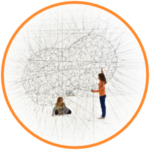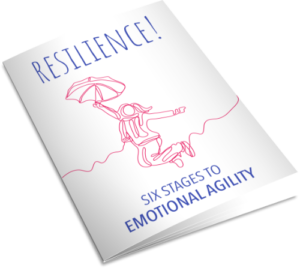Emotional agility is a process that enables us to navigate life’s twists and turns with self-acceptance, clear-sightedness, and an open mind.
– Susan David –

Emotional agility is a process that enables us to navigate life’s twists and turns with self-acceptance, clear-sightedness, and an open mind.
– Susan David –
Every day we pass through thousands of states: thoughts, emotions, experiences, and so on. How we deal with all these states of mind determines the quality of our lives. They influence our behavior, our relationships and how happy we are. And they largely influence the choices we make.

Emotions are indicators of behavior. The word emotion is derived from the Latin word ‘movere’, which means moving. So every emotion sets you in motion and that’s important for your survival.
For example, the increased alertness that fear evokes in you is really handy when you walk on a narrow path along a ravine.

Suppressed emotions keep us from moving in the right direction and sometimes have us make choices that don’t do us any good.
In the example of that narrow path, suppressed fear leads to life-threatening recklessness.
Emotionally agile people are able to tolerate high levels of stress and to endure setbacks, while remaining engaged, open, and receptive. They understand that life isn’t always easy, but they continue to act according to their most cherished values and pursue their main, long-term goals.
– Susan David –
Emotional agility starts with the realization that every emotion has a function and that there’s no such thing as a negative emotion. The realization that my judgment determines whether an emotion hurts or not. This pain arises when I want to avoid, ignore or suppress the emotion.
Just think of the simple example of an alarm clock: some people hate their alarm clock. But with the best will in the world, you can’t conclude that an alarm clock is a reprehensible thing in itself, can you?
The quality of an alarm clock is that it can get you in the right motion at the right time in the morning. All it does is telling you to “Get Up”. And if you do so immediately, the pain is negligible. However, if you are a snoozer, you multiply the pain by 3, or 4, or 10…
So it is not the alarm clock that causes the pain rather it is ignoring of the alarm clock.
When you understand this principle and are willing to embrace it, the path to emotional agility is open to you.

The road to emotional agility can be described in six stages:

It starts when you become aware of an emotion or a thought that you are avoiding. Often you’re not even aware of this. The bigger your suppression on a particular emotion or the deeper your negative beliefs are rooted, the harder it is to recognize that you are fighting against them.
You can increase your awareness by meditation, breathing exercises or writing. Silence your mind and focus on what you feel.
Now that you’ve discovered your constricting emotion, you can define it. The more accurate and nuanced you describe your state of mind, the better. Saying “I’m afraid” is so common, it doesn’t tell you much about your true feelings. There are countless types of fear. A fear of failure is something completely different from fear of death or fear of commitment. By nuancing your emotion, you make it easier to make the right choices, set priorities or ask for help.


Now it’s time to really face your emotion and look it in the eye. You magnify it by playing with it, acting it out or writing about it. By deepening and exaggerating every facet of your feelings, you distance yourself from them. You take control of the emotion instead of having the emotion take control over you.
Using your body has the most effect, so really try the acting part!
Thanks to working with your emotions this way, you can let go of your negative judgment. This will actually happen by itself, because when you act out your forbidden emotion, at some point you will burst into laughter or at least feel great relief.
This creates room for the positive quality of this painful feeling to manifest. Every painful emotion has a specific quality that will not show when you keep running away from that unpleasant feeling.


The emotion in its pure form triggers you to take a specific action, it calls for a certain behavior. And afterwards, you’ll realize that this behavior was exactly what was needed in this specific situation.
To some extent you can reason this, if you know what quality is hidden in each negative emotion. But when you act out your emotion physically, the positive behavior will follow without you even thinking about it.
By repeatedly working with your restrained emotions, your life will change for the better. You will become more flexible and effective and you will build confidence, balance and resilience.
Step by step you will come closer to yourself and go your own way.

In order to follow your own path with emotional agility, one thing is very important. You need to specify your most important values in life. These values will help you make the right choice, with the right intention. The emotion pushes you in the right direction but your intention makes it authentic.
The best way to illustrate this is with an obvious example:

Suppose you arrive at the station after a long train ride and you’re hungry. But you have another bus ride ahead before you’ll get home. Ignoring your hunger will make you weaken and suffer for the rest of your commute.
So the first step is to admit and accept that you are hungry. Your hunger triggers you to eat something, no matter what. And here the intention comes into the picture.
If it’s an important value for you to have a healthy lifestyle, you won’t have much trouble walking past the station’s snack bar to get a healthy fruit shake a bit further down the road.
However, if this healthy lifestyle is not a deep-rooted value for you, then there is a good chance that you will satisfy your hunger at the first snack bar.

You have listened to your emotion, but due to a lack of intention you make a less healthy choice.
So… what are your most important values in life?
Emotional agility allows you to make choices that suit who you are or who you want to be. This ultimately leads to you becoming more vital, more successful and more charismatic. You get a sense of life again and life makes more sense to you!
Emotional agility, however, does not only provide something for yourself…
If you lead the life that suits you and get fulfillment out of it, it will radiate directly to your environment. You will become an inspiration to others.

I am convinced that if everyone lived according to his or her deepest values, desires and motivations, the world would be more balanced.
We as humanity are one big organism and each of us is like a cell in this body: each with a unique specific role. It is our responsibility to search for that specific role and to live by it.
That sounds too good to be true, doesn’t it? To define what it is that you love the most and make it your work? And with doing so, you contribute most to the collective.
And yet, I believe it’s that simple.
Thus the greatest challenge is… finding answers to those existential questions.
Who am I? And what am I doing here?
Have you found answers to those questions? Then please share them in a comment below.

Do you want the six stages to emotional agility always in your pocket? Download this little foldable booklet and carry it around!
Already have the booklet and still wanting more?
Resilience! is proudly powered by WordPress